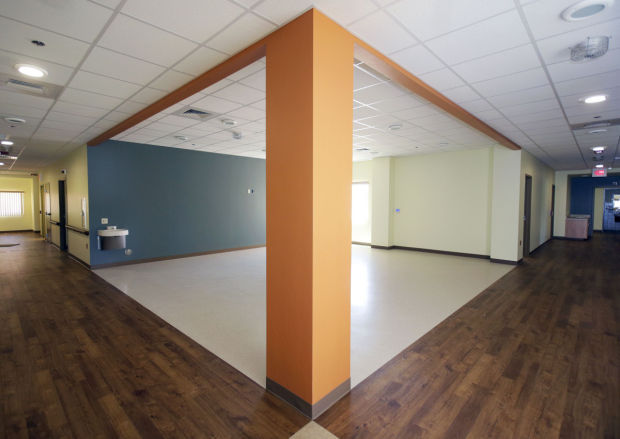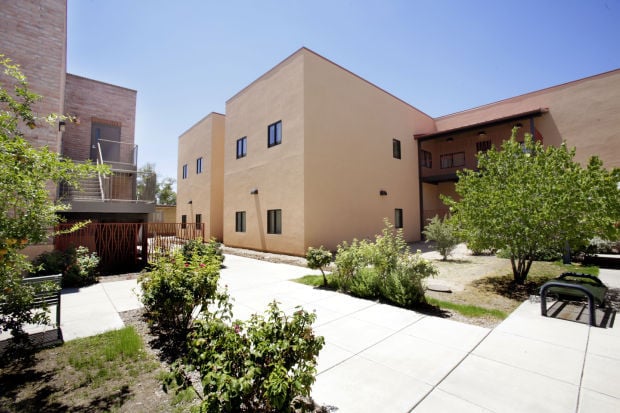Tucson Medical Center is looking for a local artist to create a mural that will provide an environment of strength, hope and resilience to older patients.
The mural will be part of the TMC Geropsychiatric Center at Handmaker — a new short-term, therapeutic mental-health service for seniors that’s inside the new, $4.5 million Paul and Lydia Kalmanovitz Elder Care Center.
The center is set to open in January at 2221 N. Rosemont Blvd. on the Handmaker Jewish Services for the Aging campus.
The two-story center, built through a partnership between TMC and Handmaker, has a total of 36 beds.
The TMC short-term-care center is on the second floor, has 16 beds, and will help older adults who are experiencing behavioral health issues such as depression, dementia, anxiety and rapid onset of impaired reality.
“It is for older people who need short-term psychiatric care and don’t fit in with the general adult population because of a cognitive impairment or medical issue, like they are in a wheelchair, needing oxygen or experiencing other issues of aging,” said Terri Waldman, director of geropsych at TMC.
The first floor of the facility, operated by Handmaker, has 20 beds for long-term care of people with dementia and Alzheimer’s disease.
The mural will be for a wall that is 7 feet wide by 13 feet tall, in the common space where activities will be held. Compensation is $5,000, which will include all supplies.
“Certainly you don’t want anything scary,” Waldman said of the artwork. “We are really focusing on people’s resilience and hope, and I want an environment that accentuates that.”
The deadline for submissions is Aug. 31, with a goal of artist selection in early September. Artists should plan for the project to commence by mid-September.
The work will be up to the selected artist’s specific vision, but TMC officials say they are looking for something that instills a feeling in the patient that the center is a good place for them at that particular point in their lives.
The goal is always to send people to the least restrictive environment, but the center can provide on a short-term basis what will ideally give people strategies for getting the most out of their lives.
Waldman expects patients will come to the center from places like hospital inpatient beds, emergency rooms, the south-side Crisis Response Center and assisted-living communities.
Waldman does not anticipate the center’s patients being people with a history of serious mental illness. Rather, she expects the patients will be people who are suffering because of age-related issues and need assistance to have a better quality of life.
“Getting old isn’t easy, and the longer we live, really the more coping strategies we acquire. But we also have a lot of losses as we age, not only of people, but of home, finances, memories, and it makes it very, very difficult for older adults to cope,” she said.
“You might be taking care of your wife with Alzheimer’s and you start to get depressed and no one understands why; you stop eating and you don’t care about life. That person will really need some assistance to have quality of life.”
The Handmaker Foundation and Tucson Medical Center received a $3 million challenge grant from the Kalmanovitz Foundation of San Francisco for construction of the new geriatrics center. The other $1.5 million was raised by the Handmaker Foundation.
The mural is part of a focus on healing art at TMC, which has a program to display local art that has a positive emotional effect.
Very abstract art, overly vivid colors and heavy patterns tend to work against a therapeutic environment for a population experiencing anxiety, TMC officials say.
Hospitals have traditionally been sterile environments with little décor, so a focus on artwork is a shift in thinking, said Michael J. Duran, vice president of the TMC Foundation.
“Research shows that art in hospitals is very healing. We want to adorn the hallways with art that will help with a speedy recovery,” Duran said.
“A number of very prominent hospitals we visited are doing this, and we used their programs as models for ours.”
TMC also referenced the work of University of Arizona researcher Dr. Esther Sternberg, who has written about the way that beautiful surroundings can dull the brain’s pain path and contribute to healing.
TMC art consultant Lauren Rabb noted that a significant number of studies show the environment can affect factors like healing time and how much pain medication patients need.
“It’s important that the environment doesn’t work against them,” Rabb said. “I was just talking to our emergency pediatric department about art for one room they have for very agitated patients. We had a long discussion of what photographs to use.”
A photo with a calming view of the sea was selected, she said.
“The hospital has four miles of corridors, so that is about eight miles of walls. There is not a lack of space to put art,” Rabb said. “Our goal is to enhance the space, make it beautiful.”





